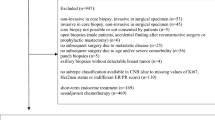Abstract
We propose multicore tissue microarray (TMA) as an alternative to whole section for routine assessment of prognostic factors in breast cancer. Since 2004, we introduced the multicore TMA for testing estrogen (ER) and progesterone receptors (PR), proliferation activity by Ki67, and HER2 overexpression and amplification in routine work. At least four tumor foci were selected on the whole section, and a dedicated technician used a stereomicroscope for accurate sampling of the selected areas. To identify a specific case in the TMA, a separate file and a computerized reporting form with the TMA map were created. A preliminary pilot study comparing the TMA results with those obtained on whole sections showed the specificity of the procedure. Moreover, in everyday diagnosis, hormone receptors were repeated on full section when negative in TMA, without significant discrepancy. Retrospective analysis of the 237 breast carcinomas studied by TMA showed the expected correspondence of tumor-grade differentiation with the hormone receptor pattern, the proliferation activity, and HER2 immunohistochemical and FISH values. In conclusion, multicore TMA may be an efficient approach in the routine study of prognostic factors in breast cancer, significantly reducing costs, time, and burden of slides necessary to accomplish these mandatory tests.



Similar content being viewed by others
References
Abd El-Rehim DM, Ball G, Pinder SE, Rakha E, Paish C, Robertson JF, Macmillan D, Blamey RW, Ellis IO (2005) High-throughput protein expression analysis using tissue microarray technology of a large well-characterised series identifies biologically distinct classes of breast cancer confirming recent cDNA expression analyses. Int J Cancer 116:340–350
Bhargava R, Lal P, Chen B (2004) Feasibility of using tissue microarrays for the assessment of HER-2 gene amplification by fluorescence in situ hybridization in breast carcinoma. Diagn Mol Pathol 13:213–216
Bubendorf L, Nocito A, Moch H, Sauter G (2001) Tissue microarray (TMA) technology: miniaturized pathology archives for high-throughput in situ studies. J Pathol 195:72–79
Camp RL, Charette LA, Rimm DL (2000) Validation of tissue microarray technology in breast carcinoma. Lab Invest 80:1943–1949
Dhanasekaran SM, Barrette TR, Ghosh D, Shah R, Varambally S, Kurachi K, Pienta KJ, Rubin MA, Chinnaiyan AM (2001) Delineation of prognostic biomarkers in prostate cancer. Nature 412:822–826
Ellis IO, Bartlett J, Dowsett M, Humphreys S, Jasani B, Miller K, Pinder SE, Rhodes A, Walker R (2004) Updated recommendations for HER2 testing in the UK. J Clin Pathol 57:233–237
Elston CW, Ellis IO (1991) Pathological prognostic factors in breast cancer. I. The value of histological grade in breast cancer: experience from a large study with long-term follow-up. Histopathology 19:403–410
Gillett CE, Springall RJ, Barnes DM, Hanby AM (2000) Multiple tissue core arrays in histopathology research: a validation study. J Pathol 192:549–553
Goldhirsch A, Glick JH, Gelber RD, Coates AS, Thurlimann B, Senn HJ; Panel members (2005) Meeting highlights: international expert consensus on the primary therapy of early breast cancer 2005. Ann Oncol 16:1569–1583
Kononen J, Bubendorf L, Kallioniemi A, Barlund M, Schraml P, Leighton S, Torhorst J, Mihatsch MJ, Sauter G, Kallioniemi OP (1998) Tissue microarrays for high-throughput molecular profiling of hundreds of specimens. Nat Med 4:844–847
Lal P, Tan LK, Chen B (2005) Correlation of HER-2 status with estrogen and progesterone receptors and histologic features in 3,655 invasive breast carcinomas. Am J Clin Pathol 123:541–546
Leake R, Barnes D, Pinder S, Ellis I, Anderson L, Anderson T, Adamson R, Rhodes T, Miller K, Walker R (2000) Immunohistochemical detection of steroid receptors in breast cancer: a working protocol. UK Receptor Group, UK NEQAS, The scottish breast cancer pathology group, and the receptor and biomarker study group of the eortc. J Clin Pathol 53:634–635
Moch H, Kononen T, Kallioniemi OP, Sauter G (2001) Tissue microarrays: what will they bring to molecular and anatomic pathology? Adv Anat Pathol 8:14–20
Nocito A, Kononen J, Kallioniemi OP, Sauter G (2001) Tissue microarrays (TMAs) for high throughput molecular pathology research. Int J Cancer 94:1–5
Rosen DG, Huang X, Deavers MT, Malpica A, Silva EG, Liu J (2004) Validation of tissue microarray technology in ovarian carcinoma. Mod Pathol 17:790–797
Rubin MA, Dunn R, Strawderman M, Pienta KJ (2002) Tissue microarray sampling strategy for prostate cancer biomarker analysis. Am J Surg Pathol 26:312–319
Sapino A, Coccorullo Z, Cassoni P, Ghisolfi G, Gugliotta P, Bongiovanni M, Arisio R, Crafa P, Bussolati G (2003) Which breast carcinomas need HER-2/neu gene study after immunohistochemical analysis? Results of combined use of antibodies against different c-erbB2 protein domains. Histopathology 43:354–362
Torhorst J, Bucher C, Kononen J, Haas P, Zuber M, Kochli OR, Mross F, Dieterich H, Moch H, Mihatsch M, Kallioniemi OP, Sauter G (2001) Tissue microarrays for rapid linking of molecular changes to clinical endpoints. Am J Pathol 159:2249–2256
Zhang D, Salto-Tellez M, Putti TC, Do E, Koay ES (2003) Reliability of tissue microarrays in detecting protein expression and gene amplification in breast cancer. Mod Pathol 16:79–84
Zhang D, Salto-Tellez M, Do E, Putti TC, Koay ES (2003) Evaluation of HER2/neu oncogene status in breast tumors on tissue microarrays. Hum Pathol 34:362–368
Acknowledgements
This work was supported by grants from the Ministry for Universities, Instruction and Research (MIUR), Rome, Italy; MURST (ex 60%), Rome, Italy; the Compagnia di San Paolo/FIRMS, Torino, Italy, and Regione Piemonte “Ricerca Scientifica Applicata” 2004 (Decreto Dirigenziale 59).
Author information
Authors and Affiliations
Corresponding author
Rights and permissions
About this article
Cite this article
Sapino, A., Marchiò, C., Senetta, R. et al. Routine assessment of prognostic factors in breast cancer using a multicore tissue microarray procedure. Virchows Arch 449, 288–296 (2006). https://doi.org/10.1007/s00428-006-0233-2
Received:
Accepted:
Published:
Issue Date:
DOI: https://doi.org/10.1007/s00428-006-0233-2




